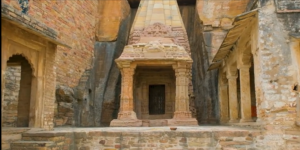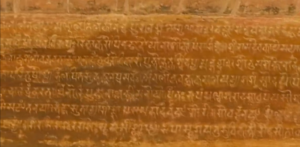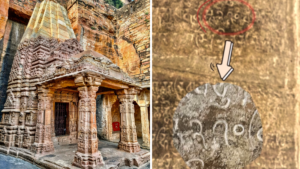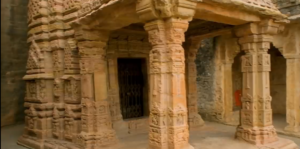Chaturbhuj Temple: A Mathematical Enigma
Chaturbhuj Temple, located on Gwalior Fort, is a testament to the rich historical and cultural heritage of India. Dating back to 876 AD, this ancient temple holds a remarkable secret that unravels the mysteries of mathematics and the concept of zero. Within its sacred walls lies the oldest recorded symbol of zero, a mathematical enigma that has shaped the course of human understanding for centuries. This temple was discovered by a person named Allah in 876AD, who was the governor of Mihir Raja Bhoj. Means it was much more older than 876 AD.

Historical Context
Gwalior, once a princely state ruled by the Rajputs and later by the Mughals, boasts a rich cultural heritage. Beyond its imposing fortifications lies a city steeped in music, art, and spirituality. The legendary musician Tansen graced these very streets, and the Gwalior Gharana flourished under his tutelage.
The Mighty Gwalior Fort
Perched atop Gopachal Parvat, the Gwalior Fort dominates the landscape. Its sandstone walls echo tales of valor and intrigue. Within its confines, palaces, temples, and reservoirs stand as testament to the architectural prowess of bygone eras. And there, amidst the ancient stones, lies the Chaturbhuj Temple.
Temple’s Connection To The Oldest Recorded Symbol Of zero
Inside the Chaturbhuj Temple, visitors can witness the early usage of zero through intricate carvings and inscriptions. The temple houses an idol of Lord Vishnu, surrounded by captivating story inscriptions that depict the rich mythological heritage of India. It is within these inscriptions that the oldest evidence of zero can be seen, in the form of the number 270.

The number 270, carved into the temple’s walls, holds a deep symbolic meaning. It refers to the size of land of garden, which was donated by the king for the construction & maintenance of the temple, symbolizing the vastness and abundance that zero represents. In the same carving it’s also mentioned about the 50 garlands, which were to be offered to the deity of the temple (Lord Vishnu) on daily basis. These carvings serve as archeological evidence, showcasing the early understanding and usage of zero in ancient India.

Chaturbhuj Temple not only unveils the historical significance of zero but also stands as a testament to the rich Indian heritage and cultural diversity. Gwalior Fort, where the temple is located, is renowned for its contribution to Indian classical music through the Gwalior Gharana. This musical tradition has produced legendary musicians and continues to thrive, adding to the cultural tapestry of India.



The Symbolic Carvings
A. The Number 270
- Inside the temple, amidst intricate carvings, lies a numerical enigma—the number 270.
- This seemingly mundane figure holds profound significance.
- Scholars believe it represents the size of land associated with the temple.
B. The Connection to Land Measurement
- The number 270 is not arbitrary; it reflects meticulous land measurement.
- In ancient India, land was often measured in hastas (a unit of length).
- The inscription suggests that the temple’s land spanned 270 hastas—a precise allocation.
C. Archaeological Significance
- These carvings serve as archaeological evidence of land ownership, temple planning, and mathematical acumen.
- They reveal the meticulous planning and spiritual devotion of the builders.
- The temple’s alignment, proportions, and spatial arrangement were carefully orchestrated.
4. Legacy and Reflections
- The Chaturbhuj Temple transcends mere architecture; it embodies a mathematical mystery.
- As we stand before its walls, we connect with ancient minds—those who carved symbols, measured land, and dreamed of eternity.
- The number 270 whispers across centuries, reminding us that every stone has a story.
The Enigma of Number 50: A Tale Within Chaturbhuj Temple
In the heart of the Chaturbhuj Temple, where ancient stones whisper secrets, lies a numerical riddle—the number 50. Let us unravel its story:
1. The Garden of Garlands
- An inscription within the temple reveals that the community planted a garden spanning 187 hastas by 270 hastas.
- Each hasta measures approximately 1.5 feet.
- This meticulously planned garden yielded 50 garlands every day.
2. The O-Shaped Digits
- Now, here’s where it gets intriguing: the last digits of 270 and 50 are O-shaped.
- These circular digits echo the ancient symbol of zero.
3. The Epigraphical Evidence
- While Indian and non-Indian texts mention zero earlier, the Chaturbhuj Temple bears the earliest known epigraphical evidence inscribed in stone.
- It already understands and uses the concept of zero.
4. The Temple’s Legacy
- The Chaturbhuj Temple, with its idol of Lord Vishnu, stands as a testament to devotion and mathematical acumen.
- The number 50, woven into its walls, reminds us that even in silence, numbers tell stories.
5. Conclusion
- As you stand before the temple, imagine the garlands, the garden, and the ancient minds that carved these symbols.
- The number 50 transcends time, connecting us to a mathematical past—a silent revolution etched in stone.
Historical Significance of Zero in Ancient India
The concept of zero holds great significance in ancient India, where it was first recognized and utilized in mathematical calculations. The presence of zero as a numerical placeholder revolutionized mathematics and paved the way for complex calculations and advancements in various fields.
The early usage of zero In Ancient India
The early usage of zero in ancient India is a captivating tale that reshapes our understanding of mathematics. Let’s explore this remarkable journey:
1. The Bakhshali Manuscript: A Hidden Treasure
- The Bakhshali Manuscript, discovered in what is now Pakistan, is an ancient Indian text dating back to the 3rd or 4th century CE.
- Composed on birch bark, this manuscript contains a wealth of mathematical knowledge and text in Sanskrit.
- Initially thought to be from the 9th century, recent carbon dating revealed that its oldest pages predate that period.
2. The Birth of Zero: A Dot with Purpose
- Across the Bakhshali Manuscript, hundreds of zeros appear, denoted using a dot.
- This dot served as a placeholder, much like how “0” indicates no tens in the number 505.
- However, it was not yet recognized as a standalone number; it was merely a convenient notation.
3. The Evolution of Zero
- The dot in the Bakhshali Manuscript would later evolve into the familiar symbol with a hole in the middle—the zero we know today.
- Indian mathematician Brahmagupta (628 AD) described this dot as a true number, marking the birth of zero as a numeral.
-
Aryabhatta: In ancient India, around the 5th century AD, the renowned astronomer and mathematician Aryabhatta introduced zero as a placeholder number in the decimal system. His pioneering work laid the foundation for zero’s role in mathematics.

-
Brahmagupta: In the 7th century AD, another Indian mathematician named Brahmagupta further developed the concept of zero. He described rules for using zero in mathematical operations. The Brahmasphutasiddhanta, attributed to him, contains the earliest known text on the number zero.
-
Middle East and Al-Khowarizmi: Zero traveled from India to the Middle East. Around 773 AD, the mathematician Mohammad ibn-Musa al-Khowarizmi synthesized Indian arithmetic and incorporated zero into the system of formulas he called “al-jabr”, which we now know as algebra.
-
Fibonacci and Europe: In the 12th century, the Italian mathematician Fibonacci (also known as Leonardo of Pisa) brought zero, along with other Arabic numerals, to Europe. His travels to North Africa exposed him to this revolutionary concept.
-
Naming Zero: The term for zero varied across cultures. In India, it was called “Sunya” in Sanskrit. In the Middle East, it became “Sifr”. The Italians named it “Zefero”, which eventually transformed into the modern English word “Zero”.
-
Collective Efforts: While specific credit for zero’s invention remains elusive, it emerged through the collective efforts of mathematicians across civilizations. Zero transcended time, bridging gaps and connecting human curiosity.
4. Why Zero?
- The concept of zero initially faced resistance and was even considered heretical.
- Yet, it became essential for the development of calculus and underpins the digital age.
- Our entire modern technology relies on the idea of something and nothing—a concept rooted in zero.
Chaturbhuj Temple’s location on Gwalior Fort
The Chaturbhuj Temple is a Hindu temple excavated in a rock face within the Gwalior Fort, located in Gwalior, Madhya Pradesh, India. The temple stands as a testament to ancient craftsmanship and spiritual devotion. Its coordinates are approximately 26°13’50.8″N, 78°10’12.1″E. The temple is accessible by air from Gwalior airport, which is approximately 119 kilometers (74 miles) away. Regular flights operate on daily basis between Delhi and Bhopal. The temple’s location within the Gwalior Fort provides a stunning backdrop of historical significance and architectural marvels.
Another architectural marvel within Gwalior Fort is Teli Ka Mandir, a stunning temple dedicated to Lord Shiva. Its towering structure and intricate carvings showcase the architectural beauty of ancient India. The presence of such magnificent structures within the fort highlights the grandeur and artistic prowess of the bygone era.
In conclusion, Chaturbhuj Temple holds a significant place in history as the oldest recorded symbol of zero. Its carvings and inscriptions provide valuable archaeological evidence of the early usage of zero in ancient India. Beyond its mathematical significance, the temple stands as a testament to the rich Indian heritage and cultural diversity. It reminds us of the importance of preserving and celebrating our historical treasures, which continue to inspire and shape our understanding of the world.



